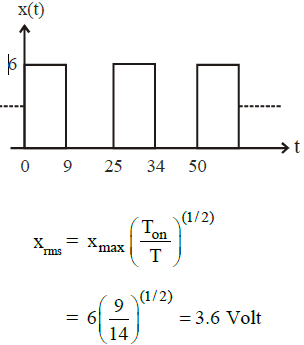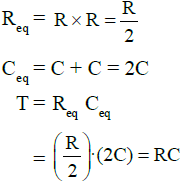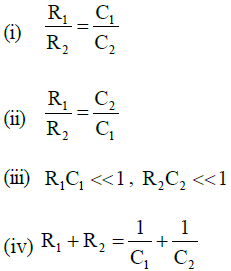41. The rms of the alternating current given by the equation i = 50sin(314t -10ot) + 30sin(314t – 20o) is
(a) 77.43 A
(b) 41.23 A
(c) 58.31 A
(d) 38.73 A
Answer: (b) 41.23 A
42. A series RLC circuit will have unity power factor if operated at a frequency of
(a) 1/ √(LC)
(b) 1- [2p √(LC)]
(c) LC
(d) 1/(LC)
Answer: (b)
43. In a balanced 3-phase system, the current coil of a wattmeter is inserted in line 1 and the potential coil across 2 and 3. If the wattmeter reads 100 W, the reactive power drawn by the 3-phase load is
(a) 141.4 VAR
(b) 173.2 VAR
(c) 50 VAR
(d) 100 VAR
Answer: (b)
Q = √3 (reading of wattmeter)
= √3 ´100 =173.2 VAR
44. An electric iron is rated at 230 V, 400 W, 50 Hz. The voltage rating 230 V refers to
(a) peak value
(b) rms value
(c) peak-to-peak value
(d) average value
Answer: (b) rms value
45. A non-sinusoidal periodic waveform is free from DC component, cosine components and even harmonics. The waveform has
(a) only half wave is symmetry
(b) half wave and odd function symmetry
(c) half wave and even function symmetry
(d) only odd function symmetry
Answer: (b) half wave and odd function symmetry
46. A periodic train of rectangular pulses x(t) with a time period of 25 seconds, has a pulse width of 9 seconds as shown in figure. The RMS value of the waveform is
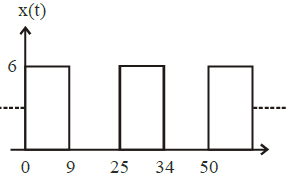
(a) 2.16 V
(b) 10 V
(c) √6 V
(d) 3.6 V
47. The time constant of the network shown in the figure is
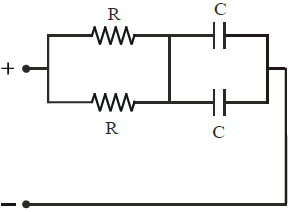
(a) 2 CR
(b) CR/4
(c) CR/2
(d) CR
48. In the series RC circuit, the voltage across C starts increasing, the moment the circuit is switched to V volts DC. The rate of increase of voltage across C at the instant just after the switch is closed (i.e. at t = 0+) is
(a) R/CV
(b) RV/C
(c) CV/R
(d) V/RC
Answer: (d) V/RC
49. Form factor of an alternating wave is
(a) Form factor = rms value´ average value
(b) Form factor = average value/rms value
(c) Form factor = (rms value)2/average value
(d) Form factor= rms value/average value
Answer: (d) Form factor= rms value/average value
50. The phase difference between the following voltage and current waves
v = 311sin(100pt + 30o)Volts
i =17sin(100pt – 20o)Amps is
(a) 30°
(b) 20°
(c) 50°
(d) 10°
Answer: (c) 50°
j = j1 – j2
Since, j1 = 30°
and j2 = –20°
Þ 30° – (–20°) = 50°
52. Which of the following material posses the least resistivity?
(a) Copper
(b) Iron
(c) Maganin
(d) Aluminium
Answer: (a) Copper
53. The resistances of insulations, in general, …….. with temperature rise
(a) does not change
(b) decreases
(c) increases rapidly
(d) increases slowly
Answer: (b) decreases
54. A10mF and a 20mF capacitor are in series. The combination is supplied at 150 V from a sinusoidal voltage source. The voltage across the 20mF capacitor is then
(a) 50 V
(b) 75 V
(c) 125 V
(d) 100 V
Answer: (a) 50 V
55. The conditions at which the following potential divider is independent of frequency, may be
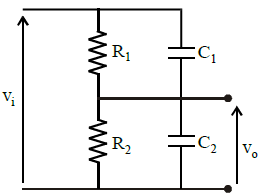
(a) (ii) is true only
(b) (ii) and (iv) are true
(c) (i) and (iii) are true
(d) (i) is true only
56. Which of the following is the best conductor of electricity ?
(a) Distilled water
(b) Warm water
(c) Salt water
(d) Cold water
Answer: (c) Salt water
57. SI unit of Electrical Energy is
(a) Volt-Ampere-second
(b) Watt-second
(c) Joule
(d) KWh
Answer: (c) Joule
58. The wave shape of current flowing through an inductor is
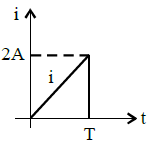
The wave shape of voltage drop (v) across the inductor is
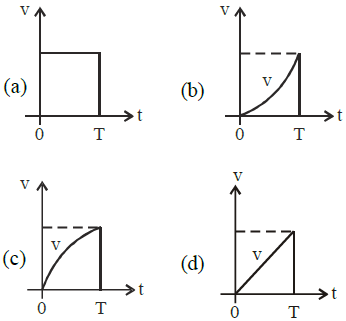
Answer: (a)
59. Two wires A and B of the same material but of different lengths L and 2L have the radius r and 2r respectively. The ratio of specific resistance will be
(a) 1 : 2
(b) 1 : 4
(c) 1 : 8
(d) 1 : 1
Answer: (d) 1 : 1
60. A 20 micro farad capacitor is connected across an ideal voltage source. The current in the capacitor
(a) will be very high at first, then exponentially decay
(b) will be very high at first, then exponentially decay and at steady state will become zero
(c) None of these are true
(d) will be zero at first, then exponentially rise
Answer: (b) will be very high at first, then exponentially decay and at steady state will become zero
